
Concept explainers
Stalevo is the trade name for a medication used fssor Parkinson’s disease, which contains L-dopa, carbidopa, and entacapone.
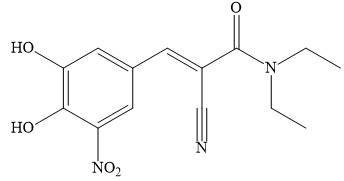
a. Draw a Lewis structure for entacapone.
b. Which
c. Which
d. Which
e. Which
f. Use curved arrows to draw a resonance structure that is an equal contributor to the resonance hybrid.
g. Use curved arrows to draw a resonance structure that is a minor contributor to the resonance hybrid.
(a)
Interpretation: A Lewis structure for entacapone is to be drawn.
Concept introduction: One should follow the given steps to draw the Lewis structure of a given skeleton structure. The first step is placing a
Answer to Problem 1.77P
A Lewis structure for entacapone is,
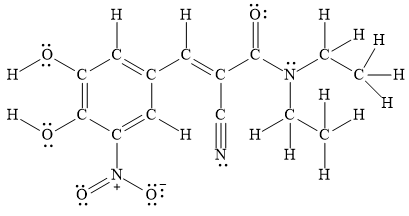
Explanation of Solution
The given structure of entacapone is in skeleton form.
One should follow the given steps to draw the Lewis structure of a given skeleton structure. The first step is placing a
Thus, a Lewis structure for entacapone is,

Figure 1
A Lewis structure for entacapone is shown in Figure 1.
(b)
Interpretation: The longest
Concept introduction: Bond length is inversely proportional to the number of electrons present between two nuclei. This means as the number of electrons present between two nuclei increases bond length becomes shorter and stronger.
Answer to Problem 1.77P
The
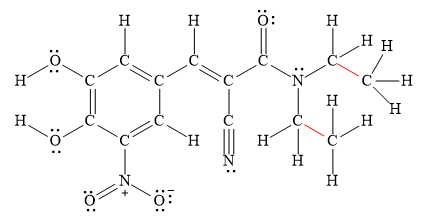
Explanation of Solution
Bond length is inversely proportional to the number of electrons present between two nuclei. This means as the number of electrons present between two nuclei increases bond length becomes shorter and stronger.
Therefore, triple bonds are stronger and shorter than double bonds, which are stronger than single bonds.
The longest

Figure 2
Thus, the
The
(c)
Interpretation: The shortest
Concept introduction: Bond length is inversely proportional to the number of electrons present between two nuclei. This means as the number of electrons present between two nuclei increases bond length becomes shorter and stronger.
Answer to Problem 1.77P
The shortest
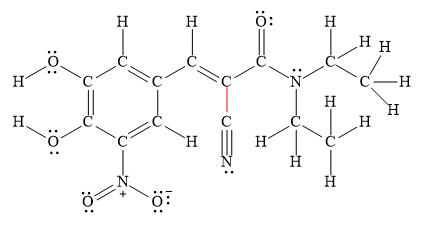
Explanation of Solution
Bond length is inversely proportional to the number of electrons present between two nuclei. This means as the number of electrons present between two nuclei increases bond length becomes shorter and stronger.
Therefore, triple bonds are stronger and shorter than double bonds, which are stronger than single bonds.
The shortest

Figure 3
Thus, the shortest
The shortest
(d)
Interpretation: The longest
Concept introduction: Bond length is inversely proportional to the number of electrons present between two nuclei. This means as the number of electrons present between two nuclei increases bond length becomes shorter and stronger.
Answer to Problem 1.77P
The longest
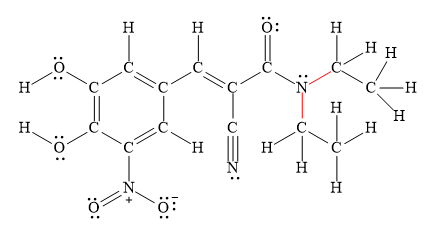
Explanation of Solution
Bond length is inversely proportional to the number of electrons present between two nuclei. This means as the number of electrons present between two nuclei increases bond length becomes shorter and stronger.
Therefore, triple bonds are stronger and shorter than double bonds, which are stronger than single bonds.
The longest

Figure 4
Thus, the longest
The longest
(e)
Interpretation: The shortest
Concept introduction: Bond length is inversely proportional to the number of electrons present between two nuclei. This means as the number of electrons present between two nuclei increases bond length becomes shorter and stronger.
Answer to Problem 1.77P
The shortest
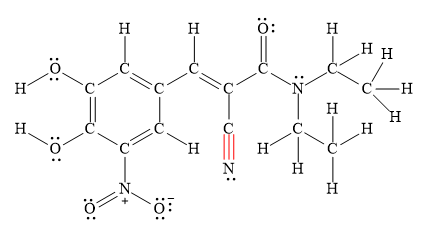
Explanation of Solution
Bond length is inversely proportional to the number of electrons present between two nuclei. This means as the number of electrons present between two nuclei increases bond length becomes shorter and stronger.
Therefore, triple bonds are stronger and shorter than double bonds, which are stronger than single bonds.
The shortest

Figure 5
Thus, the shortest
The shortest
(f)
Interpretation: A resonance structure that is an equal contributor to the resonance hybrid in entacapone is to be drawn.
Concept introduction: The delocalization of lone pair or free electrons from one atom to another is known as resonance. The stability of compound depends upon the number of resonating structures. More the resonating structures of compound more will its stability.
Answer to Problem 1.77P
A resonance structure that is an equal contributor to the resonance hybrid in entacapone is drawn below.
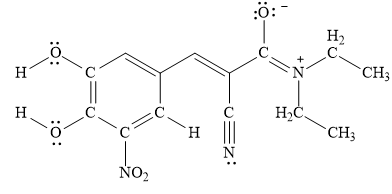
Explanation of Solution
The delocalization of lone pair or free electrons from one atom to another is known as resonance. The stability of compound depends upon the number of resonating structures. More the resonating structures of compound more will its stability.
A resonance structure that is an equal contributor to the resonance hybrid in entacapone is drawn below.
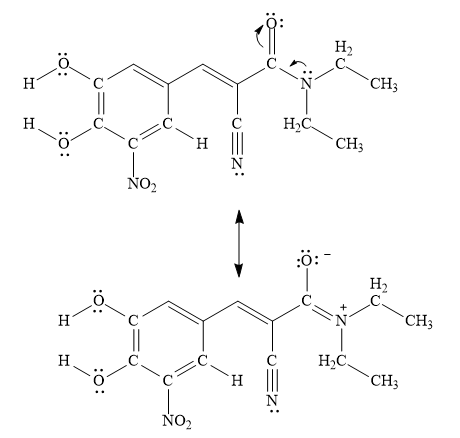
Figure 6
A resonance structure that is an equal contributor to the resonance hybrid in entacapone is drawn in Figure 6.
(g)
Interpretation: A resonance structure that is minor contributor to the resonance hybrid in entacapone is to be drawn.
Concept introduction: The delocalization of lone pair or free electrons from one atom to another is known as resonance. The stability of compound depends upon the number of resonating structures. More the resonating structures of compound more will its stability.
Answer to Problem 1.77P
A resonance structure that is minor contributor to the resonance hybrid in entacapone is drawn below.
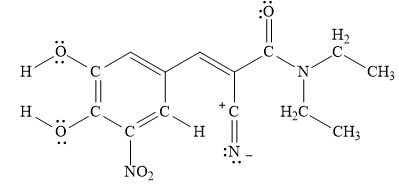
Explanation of Solution
The delocalization of lone pair or free electrons from one atom to another is known as resonance. The stability of compound depends upon the number of resonating structures. More the resonating structures of compound more will its stability.
A resonance structure that is minor contributor to the resonance hybrid in entacapone is drawn below.
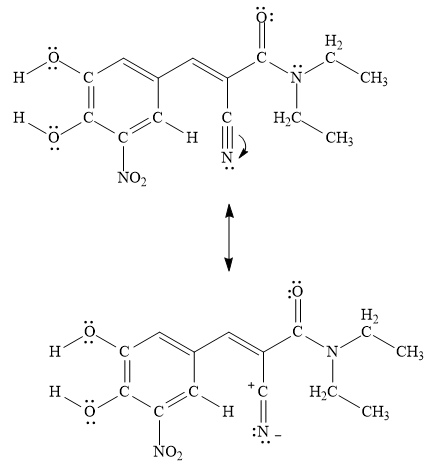
Figure 7
A resonance structure that is minor contributor to the resonance hybrid in entacapone is drawn in Figure 7.
Want to see more full solutions like this?
Chapter 1 Solutions
Organic Chemistry
- Please provide steps to work for complete understanding.arrow_forwardPlease provide steps to work for complete understanding.arrow_forwardIdentify the Functional Groups (FG) in the following molecules. Classify C atoms as tertiary, 30, or quaternary 40. Identify secondary 20 and tertiary, 30 hydrogen atoms. Please provide steps to undertand each labeling.arrow_forward
- Identify the Functional Groups (FG) in the following molecules. Classify C atoms as tertiary, 30, or quaternary 40. Identify secondary 20 and tertiary, 30 hydrogen atoms. Please provide steps to undertand each labeling.arrow_forwardIdentify the Functional Groups (FG) in the following molecules. Classify C atoms as tertiary, 30, or quaternary 40. Identify secondary 20 and tertiary, 30 hydrogen atoms. Please provide steps to undertand each labeling.arrow_forwardIdentify the Functional Groups (FG) in the following molecules. Classify C atoms as tertiary, 30, or quaternary 40. Identify secondary 20 and tertiary, 30 hydrogen atoms. Please provide steps to undertand each labeling.arrow_forward
- A certain chemical reaction releases 24.7 kJ/g of heat for each gram of reactant consumed. How can you calculate what mass of reactant will produce 1460. J of heat? Set the math up. But don't do any of it. Just leave your answer as a math expression. Also, be sure your answer includes all the correct unit symbols. mass M 0.0 x μ 00 1 Garrow_forwardPlease don't used hand raiting and don't used Ai solutionarrow_forwardDon't used Ai solutionarrow_forward

 ChemistryChemistryISBN:9781305957404Author:Steven S. Zumdahl, Susan A. Zumdahl, Donald J. DeCostePublisher:Cengage Learning
ChemistryChemistryISBN:9781305957404Author:Steven S. Zumdahl, Susan A. Zumdahl, Donald J. DeCostePublisher:Cengage Learning Chemistry: An Atoms First ApproachChemistryISBN:9781305079243Author:Steven S. Zumdahl, Susan A. ZumdahlPublisher:Cengage Learning
Chemistry: An Atoms First ApproachChemistryISBN:9781305079243Author:Steven S. Zumdahl, Susan A. ZumdahlPublisher:Cengage Learning Chemistry & Chemical ReactivityChemistryISBN:9781133949640Author:John C. Kotz, Paul M. Treichel, John Townsend, David TreichelPublisher:Cengage Learning
Chemistry & Chemical ReactivityChemistryISBN:9781133949640Author:John C. Kotz, Paul M. Treichel, John Townsend, David TreichelPublisher:Cengage Learning Chemistry & Chemical ReactivityChemistryISBN:9781337399074Author:John C. Kotz, Paul M. Treichel, John Townsend, David TreichelPublisher:Cengage Learning
Chemistry & Chemical ReactivityChemistryISBN:9781337399074Author:John C. Kotz, Paul M. Treichel, John Townsend, David TreichelPublisher:Cengage Learning Chemistry by OpenStax (2015-05-04)ChemistryISBN:9781938168390Author:Klaus Theopold, Richard H Langley, Paul Flowers, William R. Robinson, Mark BlaserPublisher:OpenStax
Chemistry by OpenStax (2015-05-04)ChemistryISBN:9781938168390Author:Klaus Theopold, Richard H Langley, Paul Flowers, William R. Robinson, Mark BlaserPublisher:OpenStax





